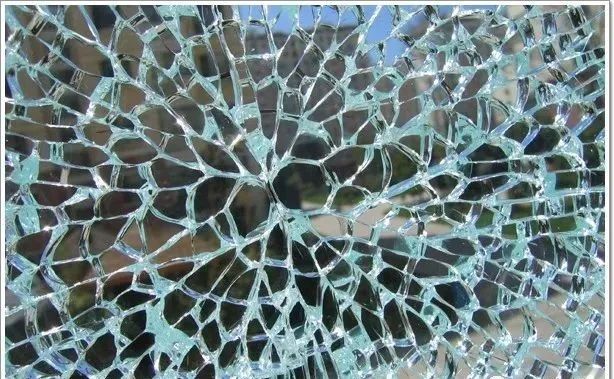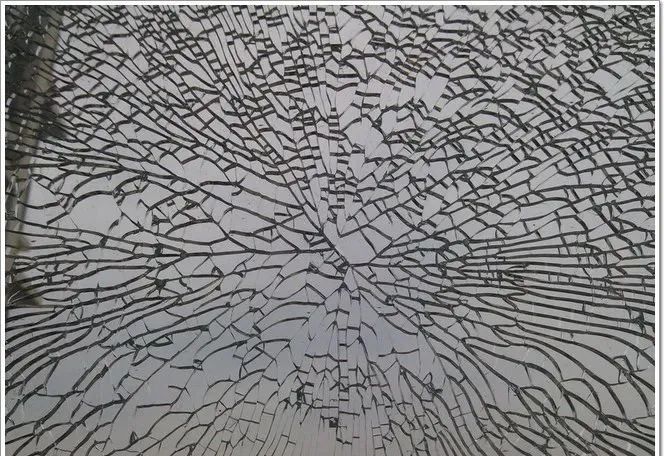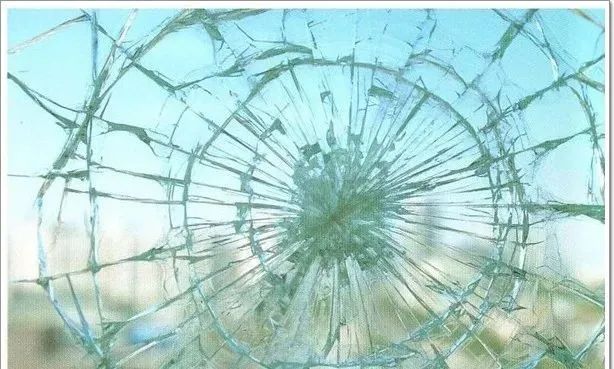
1. Self-explosion mechanism of tempered glass
The expansion of nickel sulfide inside the tempered glass is the main reason for the self-explosion of the tempered glass. After the glass is tempered, the surface layer forms compressive stress. The inner core layer is under tensile stress, and the compressive stress and tensile stress together form a balanced body.
Glass itself is a brittle material, resistant to pressure but not tensile, so most of the breakage of glass is caused by tensile stress. When the nickel sulfide crystal in the tempered glass undergoes a phase transition, its volume expands, and the nickel sulfide in the tensile stress layer of the glass plate expands to generate greater tensile stress inside the tempered glass. When the tensile stress exceeds the limit that the glass itself can bear, It will cause the tempered glass to self-explode.
Research proves that quartz sand or sandstone, the main material of glass, brings nickel, and fuel and auxiliary materials bring sulfur, which is burned and melted in a high-temperature furnace at 1400°C to 1500°C to form nickel sulfide.
When the temperature exceeds 1000°C, nickel sulfide is randomly distributed in the molten glass in the form of droplets. When the temperature drops to 797°C, these small droplets crystallize and solidify, and the nickel sulfide is in the high-temperature α-NiS crystal phase (hexagonal crystal). When the temperature continues to drop to
At 379°C, the crystal phase changes into β-NiS (trigonal crystal system) in a low-temperature state, accompanied by a volume expansion of 2.38%. The speed of this transformation process depends not only on the percentage content of different components (including Ni7S6, NiS, NiS1.01) in nickel sulfide particles, but also on the surrounding temperature.
If the phase transformation of nickel sulfide is not completely transformed, even under the temperature conditions of natural storage and normal use, this process will still continue, but at a very low speed.
When the glass is tempered and heated, the core temperature inside the glass is about 620°C, and all the nickel sulfide is in the α-NiS phase of the high temperature state. Subsequently, the glass enters the air grid for rapid cooling, and the nickel sulfide in the glass undergoes a phase transition at 379°C. Different from the float annealing kiln, the quenching time of tempering is very short, and it is too late to transform into the low-temperature state β-NiS, and the high-temperature state nickel sulfide α phase is “frozen” in the glass. The rapid and rapid cooling makes the glass tempered, forming a unified stress balance body with external pressure and internal tension.
In the tempered glass, the phase transformation of nickel sulfide continues at a low speed, and the volume continues to expand, and the force on the surrounding glass increases accordingly. The tempered glass plate core itself is a tensile stress layer. When the nickel sulfide in the tensile stress layer undergoes a phase transition, the volume expansion also forms a tensile stress. The superposition of these two tensile stresses is enough to cause the rupture of the tempered glass, that is, self-explosion.

2. Self-explosion can be divided into two types according to different causes:
One is the self-explosion caused by visible defects in the glass, such as stones, sand grains, air bubbles, inclusions, gaps, scratches, edge bursts, etc.;
Second, the self-explosion of tempered glass is caused by nickel sulfide (NIS) impurities and heterogeneous phase particles in the glass.
In 1961, BALLANTYNE first proposed the nickel sulfide mechanism of self-explosion of tempered glass. BORDEAUX and KASPERr through the study of 250 cases of self-explosion, found that the diameter of nickel sulfide causing self-explosion is between 0.04 and 0.65mm, and the average particle size is 0.2mm. Newly discovered heterogeneous phase particles cause self-explosion of tempered glass.
These are two different types of self-destruction. They should be clearly classified, treated differently, and dealt with in different ways. The former is generally visible and relatively easy to detect, so it is controllable in production.
The latter is mainly caused by the volume expansion of tiny nickel sulfide particles in the glass, which cannot be visually inspected, so it is uncontrollable. In terms of actual operation and handling, the former can generally be eliminated before installation, while the latter continues to exist because it cannot be inspected, and has become the main factor for the self-explosion of tempered glass in use.
3. Characteristics of self-explosion of uncontrollable tempered glass
The reason for the self-explosion of tempered glass is unclear, and the responsibility is difficult to ascertain. There is no certainty about the self-explosion time. It may be just out of the oven, or it may be 1-2 months after leaving the factory. There are also 1-2 years before the self-explosion of the factory. The time that causes more self-explosion of tempered glass may be 4-5 years after the completion of production .
According to incomplete understanding, the probability of most manufacturers’ products is about 3‰; the probability of individual manufacturers’ products may be even higher. The root cause of the self-explosion of tempered glass is that the glass contains nickel sulfide and heterogeneous particles. Various heat-resistant alloys used in nickel-containing alloy parts and kilns.
For oil-fired furnaces, nickel-rich condensates have been reported in small furnaces. Sulfur undoubtedly originates from sulfur-containing components in the batch material and in the fuel. When the temperature exceeds 1000°C, nickel sulfide exists in the molten glass in the form of droplets, and the solidification temperature of these small droplets is 797°C. 1 gram of nickel sulfide can generate about 1000 small stones with a diameter of 0.15 mm. Nickel sulfide can occur at any time after the production is completed, so it cannot be completely eliminated now, and there is no effective prevention method so far, which is called “cancer of glass curtain wall”.
“The cancer of the glass curtain wall” comes from the mouth of the famous architect Forster: In that year, several pieces of glass from the floor to the ceiling of the London City Hall designed by Forster & Associates broke. The town hall, near Tower Bridge, is clad entirely in glass, and contractors had to set out to check all the internal glass.
A spokesman for the Greater London City Council said that according to preliminary investigations, the problem was that the glass contained nickel sulfide, that is, the glass was contaminated by nickel elements during the construction process, and the nickel and the sulfide in the glass reacted chemically, causing cracks.
It is difficult to replace nickel sulfide after self-explosion, and the processing cost is high. At the same time, it will be accompanied by relatively large quality complaints and economic losses, resulting in dissatisfaction of the owners and even more serious other consequences. Call it “the cancer of the glass curtain wall”.

4. Tempered glass self-explosion rate and self-explosion reasons
Self-explosion rate|The self-explosion rate in China varies from manufacturer to manufacturer, ranging from 3% to 0.3%. Generally, the self-explosion rate is calculated in units of pieces, without considering the area size and glass thickness of a single piece of glass, so it is not accurate enough, and it is impossible to make a more scientific comparison with each other.
In order to uniformly measure the self-explosion rate, a unified assumption must be determined. Set uniform conditions: every 5 to 8 tons of glass contains a nickel sulfide that is enough to cause self-explosion; the average area of each piece of tempered glass is 1.8 square meters and the nickel sulfide is evenly distributed.
Then the calculated self-explosion rate of 6mm thick tempered glass is 0.64%~0.54%, that is, the self-explosion rate of 6mm tempered glass is about 3‰~5‰. This is basically consistent with the actual value of China’s high-level processing enterprises.
Even if it is produced completely according to the standard, the self-explosion of tempered glass cannot be completely avoided. Large buildings can easily use hundreds of tons of glass, which means that nickel sulfide and heterogeneous phase impurities in the glass are very likely to exist, so self-explosion of tempered glass is still inevitable despite heat soaking treatment.
5. How to identify self-explosion of tempered glass
First of all, check whether the detonation point (tempered glass cracks are radial and have starting points) is in the middle of the glass, such as at the edge of the glass, usually because the glass has not been chamfered and edged or the edge of the glass is damaged, resulting in stress concentration and cracks gradually develop. Caused; if the initiation point is in the middle of the glass, see if the initiation point has a pattern (butterfly spot) composed of two small polygons similar to two butterfly wings.
If there should be small black particles (nickel sulfide stones) visible to the naked eye, it can be judged to be self-explosive; otherwise, it should be destroyed by external force.
The typical feature of glass self-explosion is butterfly spots. The glass shards are distributed radially, and there are two pieces of glass shaped like butterfly wings in the center of the radiation, commonly known as “butterfly spots”. The nis stone is located on the interface of two “butterfly spots”.
Radial stress r≥a Tangential stress r≥a The stress at the interface between particles and glass For heterogeneous particles in the glass matrix, the temperature difference during cooling is negative, so the radial stress around the particles is pressure, and the tangential stress is pull.
Scanning electron microscope image and edge extrusion morphology of spherical elemental silicon particles in the middle layer of glass. The radial stress around the particles is pressure, and the tangential stress is tension. Therefore, tangential stress is the source of crack initiation.
